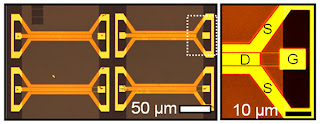
Schematic exploded view of a radio-frequency transistor that uses parallel, aligned arrays of carbon nanotubes for the semiconductor. | CHAMPAIGN, Ill. — Carbon nanotubes have a sound future in the electronics industry, say researchers who built the world’s first all-nanotube transistor radios to prove it.
The nanotube radios, in which nanotube devices provide all of the active functionality in the devices, represent “important first steps toward the practical implementation of carbon-nanotube materials into high-speed analog electronics and other related applications,” said John Rogers, a Founder Professor of Materials Science and Engineering at the University of Illinois. |
Rogers is a corresponding author of a paper that describes the design, fabrication and performance of the nanotube-transistor radios, which were achieved in a close collaboration with radio frequency electronics engineers at Northrop Grumman Electronics Systems in Linthicum, Md.
The paper has been accepted for publication in the Proceedings of the National Academy of Sciences, and is to be published in PNAS Online Early Edition this week.

Optical micrograph of an array of devices on a quartz wafer. The inset provides a magnified view. Images courtesy John Rogers | “These results indicate that nanotubes might have an important role to play in high-speed analog electronics, where benchmarking studies against silicon indicate significant advantages in comparably scaled devices, together with capabilities that might complement compound semiconductors,” said Rogers, who also is a researcher at the Beckman Institute and at the university’s Frederick Seitz Materials Research Laboratory. |
Practical nanotube devices and circuits are now possible, thanks to a novel growth technique developed by Rogers and colleagues at the U. of I., Lehigh and Purdue universities, and described last year in the journal Nature Nanotechnology.
The growth technique produces linear, horizontally aligned arrays of hundreds of thousands of carbon nanotubes that function collectively as a thin-film semiconductor material in which charge moves independently through each of the nanotubes. The arrays can be integrated into electronic devices and circuits by conventional chip-processing techniques.

A. Block and circuit diagrams of a radio that uses carbon nanotubes for the resonant antenna, two radio-frequency amplifiers, radio-frequency mixer and an audio amplifier. B. Image of the nanotube-transistor radio, with magnified views of carbon-nanotube transistors wire bonded into dual in-line packages. Images courtesy John Rogers. | “The ability to grow these densely packed horizontal arrays of nanotubes to produce high current outputs, and the ability to manufacture the arrays reliably and in large quantities, allows us to build circuits and transistors with high performance and ask the next question,” Rogers said. “That question is: ‘What type of electronics is the most sensible place to explore applications of nanotubes?’ Our results suggest that analog RF (radio frequency) represents one such area.”
As a demonstration of the growth technique and today’s nanotube analog potential, Rogers and collaborators at the U. of I. and Northrop Grumman fabricated nanotube transistor radios, in which nanotube devices provided all of the key functions.
The radios were based on a heterodyne receiver design consisting of four capacitively coupled stages: an active resonant antenna, two radio-frequency amplifiers, and an audio amplifier, all based on nanotube devices. |
Headphones plugged directly into the output of a nanotube transistor. In all, seven nanotube transistors were incorporated into the design of each radio.
In one test, the researchers tuned one of the nanotube-transistor radios to WBAL-AM (1090) in Baltimore, to pick up a traffic report.
“We were not trying to make the world’s tiniest radios,” Rogers said. “The nanotube radios are a demonstration, an important milestone toward building the technology into a form that ultimately would be commercially competitive with entrenched approaches.”
Contact: James E. Kloeppel Physical Sciences Editor
kloeppel@uiuc.edu 217-244-1073
University of Illinois at Urbana-ChampaignTechnorati Tags:
Nano or
Nanotechnology and
Nanotech or
University of Illinois at Urbana-Champaign and
Carbon nanotubes or
Why the web tells us what we already know and
Chinese New Year of the Rat, Wu Zi, 4705 and
Nanowires hold promise for more affordable solar cells or
Harriet Tubman

















No comments:
Post a Comment